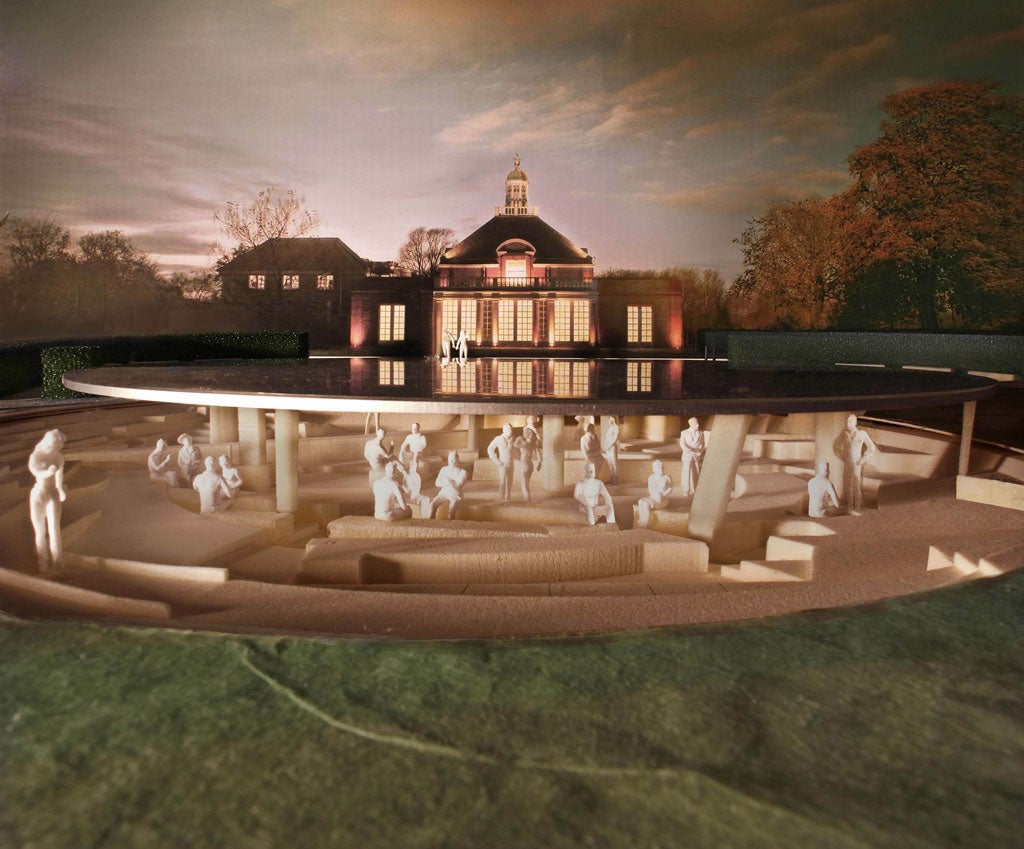Memories of the far pavilions: A sneak preview of this year's offbeat addition to Hyde Park

Can a large, cork-lined hole in the ground in London's Hyde Park – with a steel disc floating above it, mind – be architecture? It can if it's designed by Herzog & de Meuron, and Ai Weiwei, the Chinese artist considered a threat to cultural order by his country's political apparatchiks.
The hole in question, which opens to the public on 1 June, will be the latest and by far the strangest of the 12 temporary summer pavilions sanctioned by the Serpentine Gallery's gallery's directors, Julia Peyton-Jones and Hans Ulrich Obrist.
Last year's pavilion was a hortus conclusus, or secret garden, designed by the Swiss magus Peter Zumthor. It was controversial because it possessed none of the architectural wow-factor associated with every pavilion before it. The structure's matt-black form was deliberately unremarkable, and the garden itself no more than a delicate, self-effacing haze of flower heads and greenery. It was a monkish place of stillness and retreat.
If we thought that building was mysterious, Herzog and Ai have taken the Serpentine's pavilion game a quantum jump further. They've got metaphysical. You may wonder how a landscaped, 1.5 metre-deep declivity in a royal park can be anything but a stark physical fact. But hunkered down inside this pavilion, with its stainless steel disc-roof floating a few feet above your head, what you see, feel, and touch will seem fugitive, a strangely patterned ground, a riddle of the past.
Herzog and Ai have previous, in terms of creating the unexpected. They worked together on the design of the main stadium at the Beijing Olympics, the supersized Bird's Nest that was a status-symbol of dazzling ambiguity, a metaphor for both China's internationally burnished self-image, and the country's chaotic socio-economic changes.
On a sunny April day in Basel, Switzerland, gazing down at the drawings and models on a long table in Herzog & de Meuron's studio overlooking the Rhine, the pavilion's design is revealed as an expressive memorial, an act of archaeology that is also a critique of the world's uncritical appetite for architectural icons.
"Our first idea was to do another pavilion, an object," explains Herzog. "But we thought – everything's been done. We don't need to be so crazy, or expressionist. Ai said, let's go down. So we said we could go underground, to be invisible, or make a landscape feature. So let's go underground until we reach the water table. And we can discover traces of things that had been done before – the other pavilions that had left their traces. The pavilion's a fact, but it's not a structure. It's architecture. We make a virtual trip down. We know what is happening. Everything is recorded. These are facts." But it's not as simple as that. The "facts" that Herzog speaks of will be hard to decipher. Indeed, pointing to one early model for the pavilion, he compares the shapes in it to figures in a chess game.
The model also suggests the stones and buried chamber of an Iron Age Cornish fogou.
Conferring with Ai using Skype – "it was very relaxed" – Herzog mapped and modelled the foundations of the previous pavilions and based the design of the new pavilion's underground topography on these buried lines and marks.
"Most of the steel and concrete foundations have gone," notes Herzog. "But they are ghosts. You can still see where they were." The pavilion will be a place where the remains of the 11 earlier pavilions will be experienced, but not in a precise way.
A bird's-eye-view of the pavilion's extruded landscape looks faintly Cubist, or like a rusty bronze medallion with an embossed, Escher-esque riddle. The steel disc will be held above the cork-coated excavation by 12 columns, and is likely to be used as a 25mm-deep pond, or an open-air dance space for up to 100 people. Herzog describes the disc as the pavilion's Ellsworth Kelly moment, and Kelly's circular reliefs fit that claim well enough.
"We wanted a pavilion that was architecture in a very pure archaic way, that would be a paradox, but as pure and objective as possible," he says. "And as independent as possible from our own formal vocabularies, experiences, and tastes. We're not interested in symbolism or irony. We have pleasure in what's there. Ai Wei Wei is so factual. He likes the immediate." Later, sitting in the small garden behind his studio's common room, Herzog muses that one of the roles of an architect "is to bring things back to something natural. No ideology, no bullshit."
This kind of talk is a bracing antidote to the client spreadsheets, remorseless cost-cutting, and fearful design that infects most current architecture. And I'm reminded of a conversation that I had with Herzog in 2006, while we ate muesli from bizarrely huge glass goblets in a Basel cafe. "Only the conceptual artist can survive," he said then. "The others are watchmakers, presenting their architecture as a brand, like a new watch that comes out in the spring."
Herzog and Ai have designed a nexus of undead buildings, an opened tumulus where a very different kind of architectural watch is involved. It has no brand, and it ticks backwards and stops in 2000, with the first Serpentine pavilion, designed by Zaha Hadid. This is the architecture of palimpsests, the faint forensic marks and auras of the past.
Serpentine Gallery Pavilion, Hyde Park, London W2 (www.serpentinegallery.org) 1 June to 14 Oct
Subscribe to Independent Premium to bookmark this article
Want to bookmark your favourite articles and stories to read or reference later? Start your Independent Premium subscription today.

Join our commenting forum
Join thought-provoking conversations, follow other Independent readers and see their replies